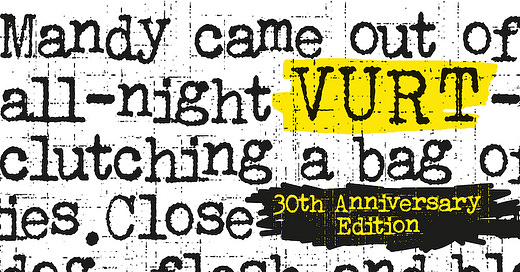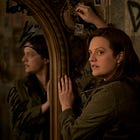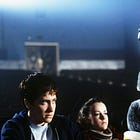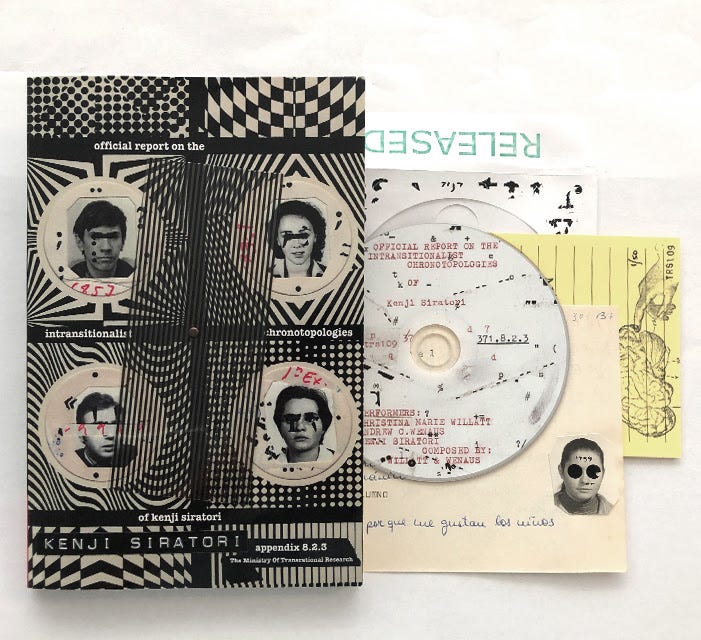A young boy puts a feather into his mouth… The Stash Riders: Scribble, Beetle, Bridget, Mandy, Tristan and Suze… The Thing from Outer Space, Game Cat, Dingo Tush, Bottletown, robodogs, droidlocks, and dreamsnakes… It’s about drugs and droogs. It’s about their misadventures in this and that Other world: Vurt. Scribble’s sister, his lover, Desdemona is lost, lost to the Vurt, that feathered, nethered world spinning somewhere inside of this one. If he is to get her back, if he is to grab her, he has to let go of something else.
I’m not telling this very well. I’m asking for your trust on this one. Here I am, surrounded by wine bottles and mannequins, salt cellars and golf clubs, car engines and pub signs. There are a thousand things in this room, and I am just one of them. The light is shining through my windows, stuttered by bars of iron, and I’m trying to get this down with a cracked-up genuine antique word processor, the kind they just don’t make any more, trying to find the words.
Sometimes we get the words wrong.
Sometimes we get the words wrong!
— Jeff Noon‘s Vurt, (p. 151)
In his introduction to Noon’s Cobralingus (Codex, 2001), Michael Bracewell writes, “Much of Noon’s best known imagery… derives its power from the literalizing of poetic language and the concretizing of images: the sudden opening up, within the landscape of the prose itself, of new routes to character and narrative, enabled by altering the meanings of words within the containers of their language.” The Shining Girls author, Lauren Beukes says that Vurt blew her mind, “not just for the story and the characters which absolutely caught the mood of where we were, but pushed language in insanely playful ways and delivered a kicker of an ending.” She cites Noon’s best known aphorism: “Form is the host; content is the virus.” To wit, Vurt‘s virus has infected everything from Beukes’ Moxyland (Angry Robot, 2008) to Steven Hall’s The Raw Shark Texts (Canongate, 2007).
“Vurt was written in a kind of dream state,” according to Noon. “I was working at Waterstone’s bookshop in Manchester during the day and writing it at night, usually really late into the early morning.” It started as half a play. “I’d spent a good number of years trying to make some money by writing plays, with no real success,” he says, “Someone else working there [at Waterstone’s] was a fringe theater director and was always asking me to write him a play.” Noon took Octave Mirbeau’s 1899 novel The Torture Garden and adapted it through the then new idea of virtual reality news of which was trickling over from America via magazines like Mondo 2000. When his director friend moved to Hong Kong, another co-worker started a small press and, being a fan of his plays, asked Noon to try writing a novel. He agreed. “And quite naturally,” he adds, “I took the basic plot I’d added to The Torture Garden as my starting point. It grew organically from that seed.”
Why? A voice told me to do it.
Which voice? The one that never stops.
— Jeff Noon’s Vurt, (p. 177)
In his book-length analysis, Andrew Wenaus distinguishes Vurt from other genre novels by pointing out its setting: Manchester, England. It’s grounded cyberpunk. It doesn’t ripple across international borders. It rips through multiple Manchesters. I found Noon’s book via the blurbs on the back of Doug Rushkoff‘s first novel, Ecstasy Club (1997), sometime during the wild-at-heart and weird-on-top 1990s. The music of that time is woven deep in the language of Vurt. Music is “without doubt my favourite art form,” says Noon, “and the one that saturates my waking life from morning till night. So, I always try to use techniques invented by musicians in my novels and stories, simply because musicians seem to get there first these days, in terms of an avant–pulp interface.” Among its pages you can hear the manic Madchester music of Happy Mondays, Stone Roses, The Charlatans, and Inspiral Carpets. Bracewell writes, “More than any other writer of his generation, Jeff Noon has assimilated the techniques developed in the recording of music and pioneered their literary equivalents,” and Noon explains, “My main insight was to realize that words, whilst seemingly fixed in meaning, are in fact a liquid medium. They flow. The writer digs channels, steers the course.”
Through the looking-glass course of Vurt, one can see shades of Twin Peaks, A Clockwork Orange, Neuromancer, Snow Crash, Star Wars, Donnie Darko, and Philip K. Dick, among other things. Vurt won the Arthur C. Clarke Award in 1994, and William Gibson called it “really fresh and peculiar at a time when we were constantly being told that lots of SF novels were really fresh and peculiar, but they often weren’t, particularly.” It is certainly fresh and peculiar — even now. The thing that makes it not only so poignant but also timeless is its passion. Under all of the made-up slang, vivid imagery, adjacent dimensions, drug talk, and other detritus of rave culture, there lies the urgency of a real human heart beating, the heart of a writer who cares about things.
We’re all out there, somewhere, waiting to happen.
— Jeff Noon’s Vurt, (p. 87)
Noon says of Vurt, “Like many a first novel it came out of a weird Venn diagram of influences: Gibson, Ballard, Borges, Lewis Carroll, techno music, dub culture, Mondo 2000, graphic novels, 1970s punk, and everyday life in the North of England in 1993. It’s amazing to think that Vurt is still on its journey, still traveling, and still finding new readers.” The newly released 30th Anniversary Edition is further evidence of that. This edition features a new Introduction by Adam Roberts, and a new Afterword by Noon himself about how the book was written.
If you’ve yet to take the trip, your yellow feather awaits.
ICYMI:
Jeff Noon, Andrew Wenaus, and I — among many, many others — contributed to…
Official Report on the Intransitionalist Chronotopologies of Kenji Siratori
The Official Report on the Intransitionalist Chronotopologies of Kenji Siratori is a 163 page paperback book, with an accompanying soundtrack, available today on Bandcamp for Bandcamp Friday! It’s a conceptual collaboration between cult Japanese author, Kenji Siratori, the Canadian electro-acoustic duo Wormwood, and a host of well known academics, write…
Many thanks to Jeff Noon for providing additional information about the new version of Vurt.
And thanks to you for reading,
-royc.
http://roychristopher.com








